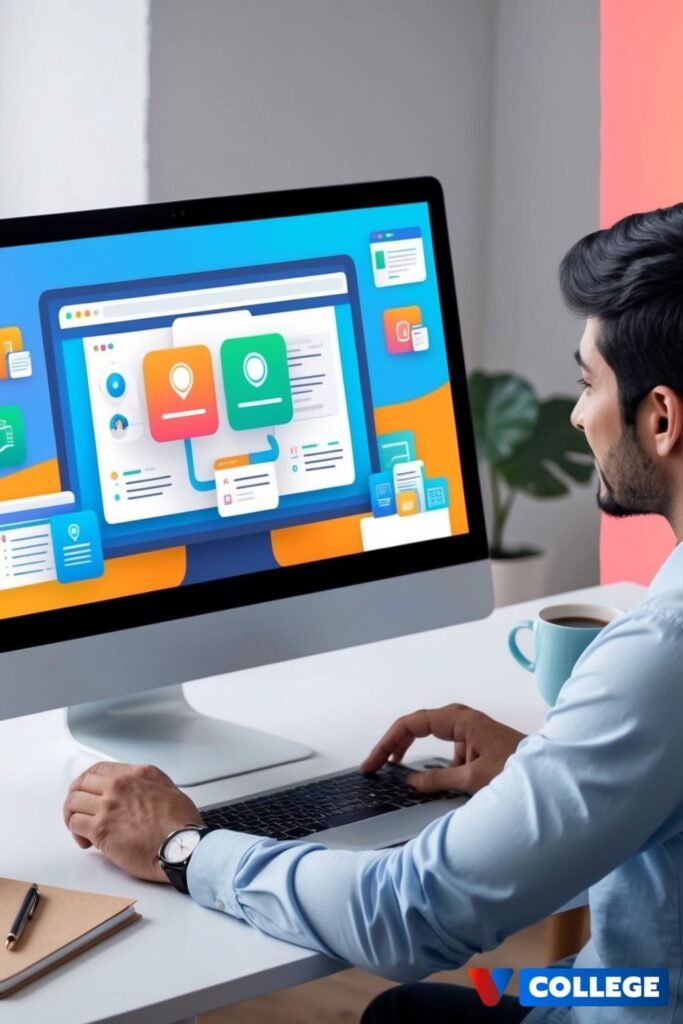Introduction: The Rise of Digital Learning
The education landscape has undergone a revolutionary transformation in recent years. Traditional classroom settings, while still valuable, are increasingly complemented—or even replaced—by digital learning platforms. E-learning has grown beyond just online courses; it now encompasses interactive modules, virtual classrooms, gamified Digital Learning, AI-driven personalized instruction, and global collaboration tools.
The COVID-19 pandemic accelerated the adoption of digital learning, highlighting its flexibility, accessibility, and scalability. Today, millions of learners—from primary school students to professionals seeking upskilling—rely on e-learning to achieve their educational goals. This article explores 7 ways e-learning is changing education forever, demonstrating why digital learning is not just a trend but a paradigm shift in knowledge acquisition.
In the last decade, the world of education has witnessed a massive transformation, driven by technology and digital innovation. Traditional classroom Digital Learning, once the cornerstone of education, is being supplemented—and sometimes replaced—by e-learning platforms that deliver knowledge in flexible, interactive, and personalized ways. The COVID-19 pandemic accelerated this transition, forcing educators, students, and institutions to adapt to digital solutions rapidly. Today, e-learning is not just an alternative; it is reshaping the entire educational landscape. This article explores seven transformative ways e-learning is changing education forever.
1. Accessibility: Learning Without Boundaries
One of the most transformative aspects of Digital Learningis its ability to break down barriers to education. Traditional learning often depends on physical classrooms, fixed schedules, and geographic proximity to institutions. Digital learning, however, allows students to access high-quality education from anywhere in the world. Whether a learner is in a remote village, traveling for work, or managing family responsibilities, e-learning ensures that knowledge is just a click away.
Accessibility goes beyond location. E-learning platforms are designed to cater to diverse Digital Learning needs, including students with disabilities. Features like screen readers, captions, adjustable fonts, and interactive interfaces make Digital Learning inclusive for all. Furthermore, learners from different socio-economic backgrounds can benefit from affordable or free online courses, eliminating financial constraints that may otherwise hinder education.
Global collaboration is another advantage. Virtual classrooms, discussion forums, and group projects enable students from different cultures and countries to connect, share ideas, and learn collectively. This interconnected approach not only broadens perspectives but also nurtures essential skills for the modern world, such as teamwork, communication, and cross-cultural understanding.
In essence, e-learning democratizes education, offering Digital Learning without boundaries and empowering everyone, everywhere, to access the tools they need to succeed.
E-learning breaks down geographical, financial, and physical barriers. Students from remote villages or developing nations can access the same quality of education as those in urban centers. Platforms like Coursera, Khan Academy, and edX provide free or affordable courses from top universities and institutions worldwide.
Key Impacts
- Geographical Freedom: No need to relocate for education—students can learn from anywhere.
- Inclusive Education: Learners with disabilities benefit from tailored accessibility features like subtitles, screen readers, and adjustable fonts.
- Cost-Effective Learning: Traditional tuition fees, commuting, and accommodation costs are significantly reduced.
Example
A student in rural India can take a MIT computer science course online without leaving their village, gaining skills that were previously inaccessible.

2. Flexibility: Learn at Your Own Pace
Flexibility is one of the key advantages of Digital Learning, allowing students to take control of their education. Unlike traditional classrooms, which follow rigid schedules, digital learning enables learners to study at times that suit their individual routines. Whether it’s early morning, late at night, or during breaks at work, students can access lessons whenever convenient, turning otherwise unproductive moments into opportunities for growth.
This self-paced approach benefits not only learners with busy schedules but also those who need extra time to fully understand complex concepts. Digital Learning platforms often allow students to pause, rewind, and revisit lessons as many times as needed, ensuring mastery before moving on. This reduces stress and increases confidence, as learners are not pressured to keep pace with an entire class.
Mobile Digital Learning further enhances flexibility. With smartphones, tablets, and laptops, education can happen anywhere—on commutes, during travel, or at home. Apps and downloadable content make it possible to study offline, giving learners complete freedom over when and where they engage with material.
By allowing students to learn on their own terms, e-learning transforms education into a highly personalized and adaptable experience, fostering better understanding, retention, and long-term success.
One of the most significant advantages of Digital Learning is the flexibility to learn anytime, anywhere. Unlike conventional classrooms, digital learning allows learners to progress at their own pace, accommodating different Digital Learning styles.
Key Benefits
- Self-Paced Learning: Students can spend more time on challenging topics and move quickly through familiar material.
- Balance with Work and Life: Professionals and parents can integrate Digital Learning into their busy schedules.
- Customizable Learning Paths: Many platforms offer modular courses, letting learners choose topics most relevant to their goals.
Example
Online platforms like Udemy allow learners to pause, rewind, or revisit lectures anytime, enabling mastery Digital Learning rather than rote memorization.
3. Personalized Learning: Education Tailored to You
E-learning transforms education by offering personalized Digital Learning experiences that adapt to each student’s needs, pace, and preferences. Unlike traditional classrooms, where one teaching style must serve all learners, digital platforms use data analytics and adaptive algorithms to tailor lessons to individual strengths and weaknesses. This ensures that students focus on areas requiring improvement while advancing quickly through concepts they already understand.
Personalization also extends to learning styles. Visual learners can access videos and infographics, auditory learners benefit from podcasts and narrated lessons, and kinesthetic learners engage with interactive simulations and exercises. This multi-modal approach increases engagement, understanding, and retention.
Moreover, adaptive learning platforms provide real-time feedback, allowing students to track progress, set goals, and adjust their study strategies. Gamification elements, such as badges, leaderboards, and challenges, further motivate learners, making education both effective and enjoyable.
By delivering content that is relevant, engaging, and suited to each learner, personalized e-learning empowers students to take ownership of their education. It creates a learning environment where everyone can thrive, making education more efficient, meaningful, and tailored to individual success.
E-learning leverages AI, analytics, and adaptive technologies to provide personalized learning experiences. Unlike one-size-fits-all classroom instruction, digital platforms can analyze learner behavior and adapt content accordingly.
Key Benefits
- Adaptive Assessments: Quizzes and exercises adjust difficulty based on performance.
- Targeted Feedback: Learners receive instant insights into areas needing improvement.
- Personalized Recommendations: AI suggests courses or modules aligned with interests and career goals.
Example
Duolingo uses AI to tailor language exercises, ensuring learners focus on vocabulary and grammar where they struggle most, maximizing retention and efficiency.
4. Global Collaboration and Networking
E-learning goes beyond individual learning by fostering global collaboration and networking opportunities. Digital platforms connect students, educators, and professionals from all corners of the world, creating a diverse learning environment that transcends geographical boundaries. Through virtual classrooms, discussion forums, and group projects, learners can share ideas, solve problems collectively, and gain insights from different cultural and professional perspectives.
This global interaction enhances communication, teamwork, and critical thinking skills—competencies essential in today’s interconnected world. For instance, international group assignments encourage students to navigate time zones, collaborate across cultures, and develop solutions that incorporate multiple viewpoints. These experiences mirror real-world professional scenarios, preparing learners for global careers.
Professional networking is another significant benefit. Many e-learning platforms include community features, enabling learners to connect with industry experts, mentors, and peers who share similar interests. These connections can lead to internships, collaborations, and even long-term career opportunities.
By facilitating cross-border collaboration, e-learning not only broadens educational horizons but also builds a global community of learners. It empowers students to exchange knowledge, develop essential soft skills, and create networks that extend far beyond the digital classroom.
Digital learning connects learners worldwide, fostering cross-cultural collaboration and networking. Students can interact with peers and instructors across continents, broadening their perspectives and enhancing learning outcomes.
Key Impacts
- Virtual Classrooms: Platforms like Zoom, Microsoft Teams, and Google Classroom facilitate real-time discussions.
- Discussion Forums: Learners exchange ideas, solve problems collaboratively, and provide peer feedback.
- Global Projects: Students work on international projects, gaining exposure to diverse cultures and working styles.
Example
A business student in Brazil can collaborate with peers in Germany and Japan on a case study, simulating real-world global teamwork scenarios.

5. Cost-Effectiveness: Affordable Education for All
E-learning has revolutionized access to education by making it more affordable and reducing traditional financial barriers. Conventional education often involves high costs, including tuition fees, transportation, accommodation, and textbooks. Digital learning minimizes or eliminates many of these expenses, offering learners the opportunity to gain quality education at a fraction of the cost.
Many online platforms provide free courses or affordable subscription models, allowing students from diverse socio-economic backgrounds to access world-class resources. Open Educational Resources (OER), such as free textbooks, lecture notes, and instructional videos, further democratize education, enabling learners to acquire knowledge without heavy financial investment.
Additionally, cost-effective education benefits working professionals and lifelong learners who may not have the flexibility to attend in-person programs. Online courses, certifications, and microlearning modules allow individuals to enhance skills, improve employability, and advance careers without significant financial strain or disruption to their routines.
By reducing the economic barriers to learning, e-learning ensures that education is no longer a privilege limited to a select few. It empowers students worldwide to pursue knowledge, develop skills, and achieve personal and professional growth, making education truly accessible and inclusive for all.
E-learning dramatically reduces the costs associated with education. Students no longer need to spend on commuting, accommodation, textbooks, or campus facilities, making learning more accessible.
Key Advantages
- Affordable Course Options: Many e-learning platforms offer free or low-cost courses.
- No Travel Expenses: Students can study from home without commuting.
- Digital Resources: E-books, videos, and interactive simulations replace costly physical materials.
Example
Platforms like Coursera provide university-level courses at a fraction of traditional tuition fees, democratizing access to high-quality education globally.
6. Technology-Enhanced Engagement
E-learning leverages technology to create interactive and engaging learning experiences that go beyond traditional classroom methods. Through multimedia content, simulations, quizzes, and gamified elements, students remain actively involved in the learning process, improving understanding and retention. Interactive lessons, such as virtual labs or scenario-based exercises, allow learners to apply knowledge in practical contexts, making education more dynamic and meaningful.
Technology also facilitates instant feedback, helping students understand mistakes and refine their skills immediately. Adaptive learning tools monitor progress and adjust content based on individual performance, ensuring that learners remain challenged without becoming overwhelmed. This personalized approach maintains motivation and fosters continuous improvement.
Moreover, emerging technologies such as virtual reality (VR) and augmented reality (AR) offer immersive experiences that bring abstract concepts to life. For example, medical students can explore anatomy in 3D, while history learners can virtually visit ancient civilizations. These innovations make learning experiential, memorable, and deeply engaging.
By integrating cutting-edge technology into education, e-learning transforms passive learning into an interactive journey. It empowers students to explore, experiment, and engage actively, making education not only more effective but also enjoyable and inspiring.
E-learning uses multimedia, gamification, virtual reality (VR), and simulations to make learning more engaging and interactive. This enhances understanding and retention compared to traditional lecture-based teaching.
Key Techniques
- Gamified Learning: Points, badges, and leaderboards motivate learners.
- VR and AR Simulations: Medical students can practice surgeries in VR, engineers can simulate structures, and language learners can immerse in virtual environments.
- Interactive Quizzes and Labs: Immediate feedback reinforces learning and keeps learners engaged.
Example
An anatomy student using a VR platform can explore a 3D human body, rotate organs, and understand physiological functions far better than from textbooks alone.
7. Lifelong Learning and Skill Development
E-learning promotes the concept of lifelong learning, enabling individuals to continuously develop knowledge and skills throughout their lives. In today’s fast-changing world, traditional education alone is often insufficient to keep pace with evolving industries and technologies. Digital learning provides flexible, accessible opportunities for learners to upskill, reskill, and stay relevant in their careers.
Online courses, certifications, webinars, and microlearning modules allow learners to acquire new skills on demand, from coding and digital marketing to creative arts and entrepreneurship. This adaptability empowers students and professionals alike to pursue personal interests or professional growth without being constrained by age, location, or prior education.
Moreover, e-learning encourages self-directed learning, fostering curiosity, problem-solving, and critical thinking. Platforms like Coursera, Udemy, and Skillshare offer a diverse range of courses, enabling learners to explore new fields, experiment with different topics, and build expertise at their own pace.
By making skill development continuous, accessible, and flexible, e-learning nurtures a culture of lifelong learning. It empowers individuals to adapt to change, achieve personal and professional goals, and remain competitive in a dynamic global landscape. Education thus becomes an ongoing journey rather than a finite stage.
E-learning supports continuous learning, enabling professionals and students to upskill, reskill, or explore new fields throughout their lives. The fast-changing job market demands adaptability, and digital learning offers the tools to stay competitive.
Key Benefits
- Continuous Professional Development (CPD): Workers can update skills without taking long breaks from their careers.
- Upskilling Opportunities: Learning coding, digital marketing, AI, or project management online prepares learners for emerging jobs.
- Career Advancement: Certifications and micro-credentials improve employability and career prospects.
Example
A marketing professional can take an online digital marketing specialization to stay current with trends, helping them earn promotions or transition into new roles.

Conclusion: E-Learning is Here to Stay
The rise of e-learning marks a fundamental shift in how education is delivered and experienced. From personalized learning experiences to global collaboration, cost-effective access, and technology-enhanced engagement, digital learning has transformed education into a flexible, inclusive, and dynamic process. It breaks down barriers of geography, time, and affordability, empowering learners from all walks of life to access knowledge and develop skills on their own terms.
Moreover, e-learning fosters lifelong learning, enabling individuals to continuously adapt to new challenges and opportunities. By leveraging interactive technologies, immersive simulations, and real-time feedback, it ensures that learners remain engaged, motivated, and equipped with the skills needed for success in an increasingly competitive and interconnected world.
As technology continues to evolve, the potential for e-learning will only expand, integrating AI, virtual reality, and advanced analytics to create even more personalized and effective learning experiences. Education is no longer confined to classrooms or rigid schedules—it is a continuous, accessible, and adaptable journey.
In essence, e-learning is not a temporary trend; it is the future of education. By embracing digital learning, students, educators, and institutions can unlock endless possibilities, ensuring that knowledge and skills remain within reach for everyone, everywhere.
Digital learning is not just a temporary solution; it is reshaping education forever. By providing accessibility, flexibility, personalization, global collaboration, affordability, engagement, and lifelong learning opportunities, e-learning empowers individuals to take control of their education.
As technology continues to evolve, so will e-learning. Innovations like AI tutors, immersive VR classrooms, and blockchain-based credentialing will further enhance learning experiences. One thing is certain: the future of education is digital, and the possibilities are limitless.
Whether you are a student, professional, or lifelong learner, embracing e-learning can unlock potential, broaden horizons, and prepare you for the challenges of tomorrow.
Related Post: 7 Top Causes of Google Maps Not Working and How to Fix Them
